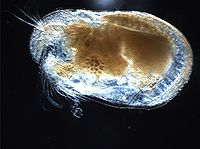
Photo from wikipedia
Abstract The δ 18 O of ostracod valves is widely used to infer water δ 18 O and temperature. However, ostracod δ 18 O appears sensitive to other environmental variables.… Click to show full abstract
Abstract The δ 18 O of ostracod valves is widely used to infer water δ 18 O and temperature. However, ostracod δ 18 O appears sensitive to other environmental variables. In addition, there is species-dependent ostracod calcite 18 O enrichment, relative to slowly precipitated inorganic calcite under the same conditions. Together these uncertainties complicate ostracod paleoclimate reconstructions. This study presents a new understanding of the causes of ostracod δ 18 O variations based on a global database of published ostracod δ 18 O values in lake, marine and coastal environments, and from culture experiments. The database includes associated field/experiment host water parameters including temperature (−1 to 32 °C), water δ 18 O (−13.2‰ to 4.3‰ VSMOW), pH (6.9–10.4), salinity (0–72 g/kg), calcite saturation states (0.6–26), and dissolved inorganic carbon concentration [DIC] (0.9–54.3 mmol/kg). The data show that: (1) the δ 18 O of marine and non-marine ostracods reflects the 18 O/ 16 O of the sum of host water CO 3 2− and HCO 3 − ions. For example, at a given temperature, the δ 18 O of non-marine ostracods decreases by 4‰ to 6‰ as [CO 3 2− ]/[DIC] reaches 70%, depending on the ostracod species. In low [CO 3 2− ]/[DIC] settings (i.e. high HCO 3 − /CO 3 2− ), ostracod 18 O/ 16 O is close to the 18 O/ 16 O of HCO 3 − ions, which explains why on average ostracod δ 18 O is higher than the δ 18 O of inorganic calcite precipitated slowly under the same conditions. (2) Taxonomic offsets in ostracod δ 18 O vary with the host water [CO 3 2− ]/[DIC]. In environments where HCO 3 − ≫ CO 3 2− (i.e. most freshwater lakes), the 18 O/ 16 O of Candonids is indistinguishable from the 18 O/ 16 O of HCO 3 − ions (difference of 0.10 ± 0.16‰) while the 18 O/ 16 O of Cyprids is lower than the 18 O/ 16 O of HCO 3 − ions by −0.77‰ to −0.32‰, Cytherids by −0.88 ± 0.29‰, and Limnocytherids by −1.12 ± 0.05‰. (3) The sensitivity of ostracod δ 18 O to [CO 3 2− ]/[DIC] also varies with taxonomy. For each percent increase in [CO 3 2− ]/[DIC], Candonids δ 18 O decreases by −0.098 ± 0.024‰, Cyprids by −0.075 ± 0.004‰, Cytherids by −0.057 ± 0.012‰, and Limnocytherids by −0.058 ± 0.005‰. (4) The similarity in 18 O/ 16 O between ostracod calcite and the sum of host water ‘HCO 3 − and CO 3 2− ’ (despite species-specific offsets) suggests rapid precipitation of a finite DIC pool in the ostracod calcifying fluid. We propose an ostracod δ 18 O model whereby the more negative the 18 O/ 16 O of a given species relative to the sum of CO 3 2− and HCO 3 − , the greater the isotopic equilibrium between the DIC pool and H 2 O in the ostracod calcifying fluid. (5) Higher host water salinities and pH induce higher [CO 3 2− ]/[DIC], resulting in lower ostracod δ 18 O, which explains the variable salinity and pH effects on ostracod δ 18 O. Our database and ostracod δ 18 O model shows that ostracod δ 18 O records from closed basin environments likely reflect high or variable [CO 3 2− ]/[DIC], rather than water temperature and δ 18 O alone. Our study reconciles contradictory observations of controls on ostracod δ 18 O and paves the way for improved paleo-environmental interpretations and reconstructions of past water [CO 3 2− ]/[DIC].
Journal Title: Geochimica et Cosmochimica Acta
Year Published: 2017
Link to full text (if available)
Share on Social Media: Sign Up to like & get
recommendations!